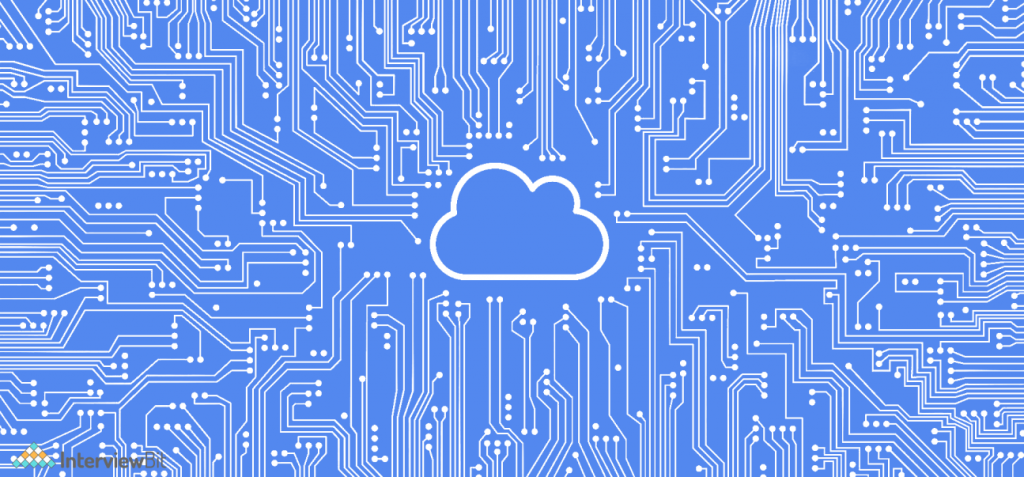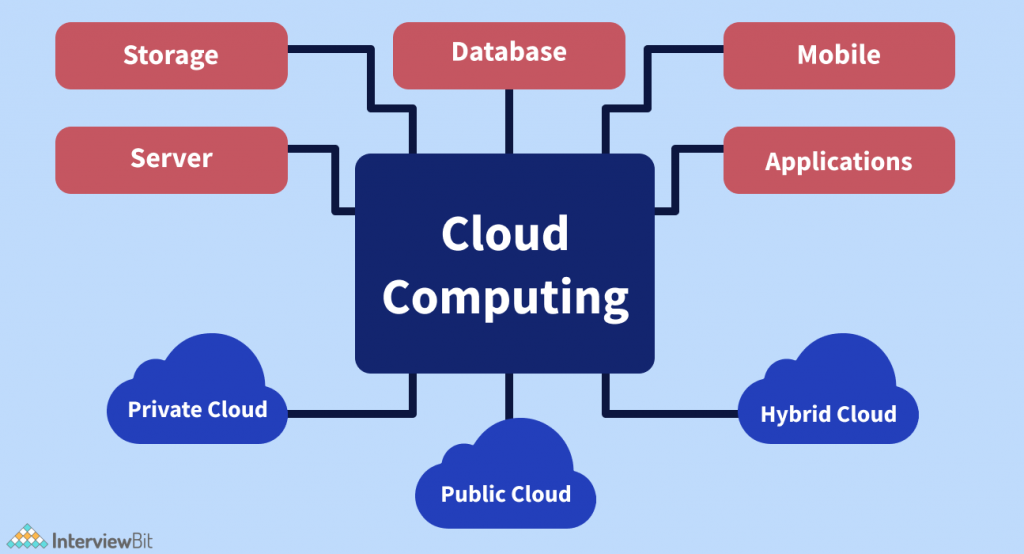- Introduction
- What is Cloud Computing?
- What are the uses of Cloud Computing?
- Top 10 Applications of Cloud Computing
- 1. Online Data Storage
- 2. Backup and Recovery
- 3. Testing and Development
- 4. Cloud Computing in Medical Fields
- 5. Big Data analysis
- 6. Entertainment Applications
- 7. Social Network Platforms
- 8. Anti-virus Applications
- 9. Accounting Application
- 10. Management Applications
- Conclusion
- FAQ’s
- Q.1: Where is Cloud Computing used?
- Q.2: What are the Real-time Applications of Cloud Computing?
- Q.3: What are the advantages of cloud computing?
- Additional Resources
Introduction
Cloud computing can be defined as the delivery of various on-demand computing services like – servers, software, storage, databases, networking, analytics, intelligence, and many more over the internet. Nowadays almost every industry is adopting one or another form of cloud computing and this is because of the numerous advantages cloud computing has. As we all know, every company consists of very few employees in the initial years and hence they only need to maintain a small database. But as the company grows with time, its data also grows, and eventually, it will need centralized storage and large databases.
In short, any company would need expensive server hardware at a certain point in time to store and maintain their company’s data. Scalability is also one of the main reasons why companies are moving to the cloud. A cloud-based application is much easier to scale in comparison to others. Not only this, in every few years much of the hardware becomes obsolete, and software companies produce new versions with additional features, so the software needs to be upgraded as well. With all of this, keeping up with innovation without hampering the budget, is next to impossible. Here comes the role of Cloud Computing. Cloud computing has so many applications and in this post, we are going to discuss the top 10 applications of cloud computing in detail.
As discussed, Cloud Computing provides every IT service we need on the internet. These computing services are provided on rent and they provide flexibility and scalability. Users can choose the services as per their requirements. So now that we have the basic knowledge of Cloud Computing, let’s quickly jump into various applications of cloud computing.
Confused about your next job?
What is Cloud Computing?

Cloud Computing provides the ability to leverage different services like – servers, software, storage, databases, networking, analytics, and intelligence with flexibility on the internet. Examples of some computing services are – Dropbox, Salesforce, Microsoft Azure etc. Cloud computing services are used by individuals for their personal use and by organizations for their business. The usage of cloud computing services highly varies from one organization to another organization. It totally depends on the requirement of the organization and which service they want to use. And that is why we have different cloud service models to serve them as per their requirements. Let us discuss each cloud service model one by one.
1. Infrastructure As A Service (IaaS)
Under this service model, we get essential computing, storage, and networking resources on demand that too on a pay-as-you-go basis. Once Organisation’s infrastructure is migrated to an IaaS Solution, it will help to reduce the maintenance costs of on-premises data centers, money on hardware costs will be saved and with the help of analytics services will help to gain real-time business insights. IaaS solutions also give the flexibility to scale IT resources up and down with demand. They also help to quickly provide new applications and increase the reliability of underlying infrastructure.
2. Platform As A Service (PaaS)
Under this service model, we get a complete development and deployment environment in the cloud. It provides complete support of the web application lifecycle, like building, testing, deploying, managing, and updating without spending on the underlying application infrastructure. It also provides all the resources needed to deliver everything from a simple cloud-based web app to the most complex enterprise applications. Here we also have the option to purchase the resources from a cloud service provider on a pay-as-you-go basis.
3. Software As A Service (SaaS)
This service model directly allows the user to connect and use cloud-based apps using the Internet. SaaS hosts the application and makes it available for the end-users to use it. The Cloud service provider for SaaS will give a complete software solution that also can be purchased on a pay-as-you-go basis. The app is rented over the Internet and users connect through a web browser. The app data is stored in the service provider’s data center only. The Service provider also takes care of the underlying infrastructure, middleware, and app software. Also according to the service agreement, the service provider ensures the availability and the security of the app and of data as well.
Based on the access to Services, there are three types of Cloud Deployment Models:
4. Private Cloud
In a Private Cloud, the services are offered to selected users only instead of the general public. These services can be accessed over the Internet.
5. Public Cloud
In Public Cloud, the services are offered by third-party providers over the public Internet. These services are accessible to anyone who wants to use or purchase them. It allows customers to pay as per the usage of the service. Unlike Private Cloud, Public Cloud can save companies from spending on on-premise hardware and application infrastructure.
6. Hybrid Cloud
Hybrid Clouds are a blend of Public Cloud and Private Clouds. It allows businesses to take advantage of both cloud models. As the demand increases beyond the capacity of the on-premises data center, businesses can leverage the Public Cloud to instantly scale up the capacity. It helps to save time and cost on the installation and maintenance of new servers.

What are the uses of Cloud Computing?
Cloud services can be leveraged at a personal level as well as at an organizational level. At the personal level (also known as the lower level), the cloud can be used to store personal data. So instead of saving all our data on local memory e.g., computer hard disk and then worrying about the capacity of the disk, we can store our data on a cloud. Now we do not have to worry about the capacity of our local memory. We also do not have to worry about our data and its accessibility. Cloud services offer some amount of capacity free of cost but in the future, if the size of our data increases, we can just extend the storage capacity by paying some amount of money. Another significant advantage of storing our data on the cloud is if someday our local memory (hard disk) got corrupted or crashes our data won’t get affected because it is stored on the cloud.
Now if we talk about the organizational level, we usually have a huge amount of data to store and as the company grows, its data also grows. Hence any organization would need more storage options or we can say it would need an expansion of storage services after a certain point of time. Also with time, the number of employees will also increase, and this will lead to an increase in the capacity of on-premise data centers. The installation and maintenance of such data centers are costly. So using a cloud is a good escape from this situation. The company will have a large space to store its data in the cloud. Now they do not need to worry about the storage capacity and computing power of their own systems. They can simply use various cloud services as per their requirements. Cloud computing also provides business insights with the help of big data analytics. Scalability is also one of the main reasons why companies are moving to the cloud. A cloud-based application is much easier to scale in comparison to others.
Top 10 Applications of Cloud Computing
Now let us see what are the real-time applications of cloud computing.
1. Online Data Storage
Organizations have a lot of data to store and with time the size of this data increases. This data can be in any format like text, image, audio, or video. Now, in order to store and maintain this huge amount of data, organizations are no longer needed to set physical storage systems. They can use Clouds to store their data. The whole data of an organization can be categorized into two types – current data and historical data. Data that is used very frequently in order to perform some day-to-day operations is known as current data. On the other hand, data that is not operational but is of value and needs to be stored is known as historical data. So, in order to store these two types of data separately, we have two storage options available:
- Hot Storage: The data which needs to be accessed right away or very frequently, is stored in this storage.
- Cold Storage: The data which does not require fast access or frequent access is stored in cold storage.
Cloud storage of data also makes it easily accessible because now you can access it from anywhere in the world with just an internet connection.
2. Backup and Recovery
Cloud service providers offer a lot of options for data recovery. They offer various recovery plans at different costs. Companies can decide which plan they need based on their requirements.
The cloud provider gives the option for data redundancy, i.e., a copy of data is stored in different places. It can be a different server or data centre or even a different geographic location. The reason for this redundant storage option is to provide safety against data and to provide flexibility in accessing the data. Suppose, at the primary location data becomes inaccessible somehow, then it can be easily accessed from other storage locations. Some data redundancy options available are:
- Locally redundant storage (LRS)
- Zone-redundant storage (ZRS)
- Geo-redundant storage (GRS)
- Geo-zone-redundant storage (GZRS)
3. Testing and Development
After the development of a product, testing plays a major role in finalizing it for deployment. Before the final delivery, a product needs to be tested properly. It must be tested on different machines with different infrastructures because the end-user of that product can be anywhere. It also must be tested for load balancing. Load balancing- How the performance of a product affects when a large number of users use it simultaneously. To accomplish such tasks testing requires different IT resources and different computer infrastructures. Now, A cloud can provide these testing features in one place. Organizations can easily test the performance of their product on the cloud against a large number of users.
4. Cloud Computing in Medical Fields
In the medical field also, cloud computing is doing wonders. It is used to store data of patients and helps to access it over the internet without any need of the physical computer set up to trace the previous records, or even doesn’t need the paperwork. In case of emergencies, the patient’s data can be accessed remotely from anywhere rather than waiting till they get access to information from the hospital computer.
5. Big Data analysis
Big Data analysis involves dealing with huge amounts of data having sizes from terabytes to zettabytes (known as big data). Now for any traditional database management system, it is very difficult to maintain this amount of data. Cloud Computing allows us to store large data sets that include structured, and unstructured data, from different sources, and in different sizes from terabytes to zettabytes. Not only the storage but also provides us various tools in order to do the analysis of this big data. Because the main purpose of storing big data is to derive something out of it.
The flexibility of the cloud makes it a good choice for big data analytics. Organizations will have a major financial advantage by using the cloud because it is much cheaper than traditional large-scale big data resources. Now they do not need to maintain large data centers. Moreover, the cloud also makes data integration from different resources much easier for organizations.
6. Entertainment Applications
Today we get a lot of entertainment content on the internet, let it be Netflix web series episodes, online games, or youtube videos. This data is widely used by users from almost all parts of the world. It is also very necessary to provide a great customer experience. So that this content is available on demand. For this, entertainment companies reach their customers through a multi-cloud strategy. With the help of the cloud, the entertainment industry is reaching new heights.
7. Social Network Platforms
Social network platforms play an important role in day-to-day life. They have changed the way of communication and interaction. These platforms have a large number of users across the globe and this makes them ideal candidates for cloud computing adaptation. Social media sites contain heavy multimedia content like images and videos and they are capable of making the whole network slow, here cloud storage comes into play. Cloud storage helps social media applications run smoothly.
Apart from data storage, cloud services also offer cost-effective analytics for these sites. Another advantage of cloud computing is data backup and recovery in case of any disaster. Social media sites store the personal data of their users and therefore they cannot afford to lose even a small part of it. If the data is only stored in one central location it can be insecure. If something happens there, it is almost impossible to recover the data. But through cloud security services they remain accessible through shared resources across the globe.
8. Anti-virus Applications
Nowadays we have cloud-based antivirus solutions which perform better than traditional antivirus software. The main reason behind this is – Cloud-based antivirus stores malware information on the cloud rather than on the user system. Traditional antivirus software is used to store malware information on the user system itself which can adversely affect the performance of the user’s system.
9. Accounting Application
Cloud-based accounting applications help an organization manage its business accounting and finances in less time, effort, expense, and labour. It allows businesses to manage their finances from anywhere in the world without compromising the security of data. Cloud-based accounting applications or software are scalable because now companies can expand their workforce without investing in the infrastructure. Cloud makes this software easy to upgrade because now we do not have to worry about our system specifications and resources.
10. Management Applications
Management Application like ‘Evernote’ is a cloud-based application. It helps to save, format, and share notes over the cloud. Evernote uses cloud computing’s storage service to store the data of the users. Because of being in the cloud storage, the data can be accessed at any time, from anywhere, and on any device. The security service of the cloud helps to keep the data secure. Also, there are no chances of data loss because of the redundant storage service that Evernote uses in Cloud Computing.
Conclusion
Cloud computing can be defined as the delivery of various on-demand computing services like – servers, software, storage, databases, networking, analytics, and intelligence over the internet. Cloud providers literally provide everything as a service. Organizations have a lot of data and on expansion, there are a lot of things to be taken care of, like data centers, increasing demand for computing and networking devices, and the need for more storage capacity. Also here the demand plays a major role, sometimes it can increase at an unexpected rate, and sometimes it can decrease abruptly. For all of this, we can migrate the company’s infrastructure to the cloud. We can automate everything here. We can set some rules to scale up as per the demand and also to scale down. Cloud also provides data security solutions. On the basis of analytics services, we can make decisions for the organization.
Nowadays cloud computing is being used in almost all industries. It has a wide application. Some of cloud computing applications examples are Social Media applications, Entertainment applications, and Meeting applications. The use of cloud computing in the medical field is doing wonders.
FAQ’s
Q.1: Where is Cloud Computing used?
Ans. Cloud Computing is used where we have to store a large amount of data and also access it from anywhere in the world. It is used to store, maintain, retrieve, and analyze data. Using the cloud as storage, at any time and place, you will have high availability, speed, scalability, and security for your environment. Cloud computing is also used as a test and development environment. It is also used for big data analytics.
Q.2: What are the Real-time Applications of Cloud Computing?
Ans. Following are some of the real-time applications of cloud computing:
- Data Storage
- Backup and Recovery
- Testing and Development
- Entertainment Applications
- Social Media Applications
Q.3: What are the advantages of cloud computing?
- Low maintenance cost
- Data Security
- Mobility
- Excellent Accessibility
- Unlimited Storage Capacity
- Scalability







 Join WhatsApp Group
Join WhatsApp Group


